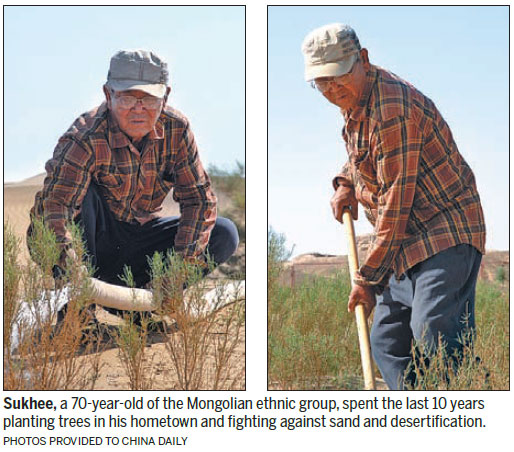Model planter inspires others to join in his forestation campaign
Sukhee, a 70-year-old of the Mongolian ethnic group, has spent 14 years battling the bleak desert that borders his hometown, striving to recover green coverage and control desertification.
Born in Ejin Banner in China's Inner Mongolia autonomous region, he resigned from his role as chairman of the Chinese People's Political Consultative Conference Alxa League Committee in 2004 and came back to his hometown with his wife.
He volunteered to live in Heicheng, meaning black city, one of the largest wind passageways in Ejin Banner and committed to planting trees to fence off the wind for more than 10 years. Sukhee said he had grown up listening to stories of Heicheng from his grandfather, so he is emotionally attached to the place.

"The place has a northwest wind blowing all year round. The sand would pile up as high as the walls of the city, almost enough to bury the city. I vowed to plant a stretch of trees to protect the historical site," Sukhee said.
In the spring of 2004, Sukhee spent more than 30,000 yuan ($4,608) and built a bungalow in the area, marking the starting point of his journey in preventing desertification.
In the following 10 years, he constructed a 16-kilometer fence around the Heicheng relics, protecting an area of 1,533 hectares. He also planted 233 hectares of saxaul forest in the wind passageway in the north of the city, with a tree survival rate of more than 80 percent.
In the desert summer, where the temperature sometimes reaches 40 C, the saxaul plants need to be watered. Sukhee had to water the little trees under the burning sun during those days.
As there is no irrigation canal system in the desert, Sukhee had to transport the water himself. To save water, he invented an innovative irrigation method, which uses a handmade water gun to inject water directly to the plants' roots.
Thanks to the new irrigation method, more than 80 percent of the 90,000 saxaul trees he planted survived. Some of them have grown to be as tall as 3 meters, which are able to fend off the strong winds.
Sukhee had thought about leaving Heicheng. But looking at the wilting seedlings under the burning sun, he said: "If I leave, they would not survive. At this point, they need me."
To cut the costs of planting trees, Sukhee built a saxaul garden, from which the seedlings produced are not just enough for his own use, but can also be provided to farmers in the surrounding area.
Under his guidance, more people joined in the campaign of planting trees there. Sukhee wrote down all the names of the volunteers to memorize those kind people and remember that the forest was not planted just by him alone.
The past 14 years have witnessed the yellow desert gradually retreating and green trees spreading.
"Those poplar trees were only 40 centimeters tall when I planted them in 2005," he said. Sukhee introduced his "treasures" to visitors, which are now as tall as 4 meters.
Besides poplar and saxaul, there is also now grass, sand jujube and sheep in the area.
Sukhee has been named a model forest planter in Inner Mongolia. But he prefers the nickname of "Heicheng's forest planting Yugong", referring to a fable in which an old man tried to move a mountain all his life.
"Planting a few more trees in my living years and leaving a good environment for the descendants of Ejin. That's my biggest wish."
liyou@chinadaily.com.cn


















